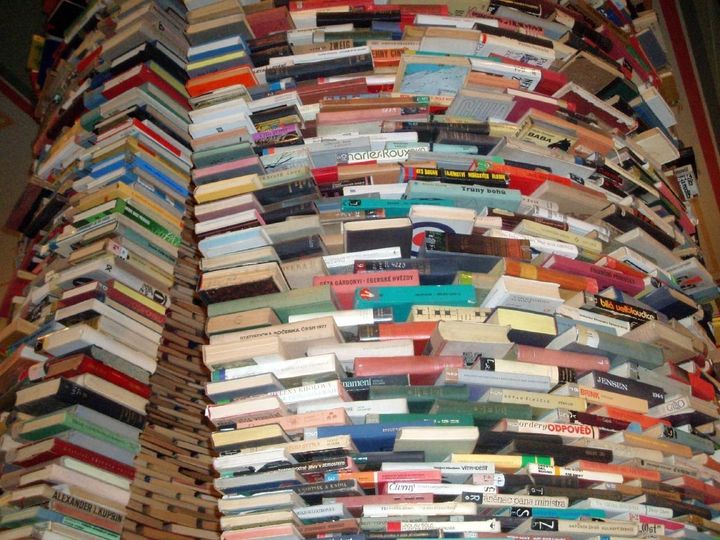
As anyone knows who has followed its fortunes over the past few decades, the story of contemporary art in Los Angeles has been a peripatetic one. The center of energy has shifted variously from La Cienega to La Brea to Downtown, out to Venice and Santa Monica and back east again to Culver City and the lower end of La Cienega. Even then, I'm probably forgetting a few stops along the way. The pattern is a familiar one: artists begin to colonize an area for the availability of large, inexpensive space for studios; once they gain a foothold, "alternative spaces" and artists' collaboratives spring up, and dealers and galleries move in for the kill; studio footage gets to be unaffordable, and the pattern starts to repeat. It's not only in Los Angeles, of course, but the city's scattered layout seems to exaggerate the pattern. All the while, hopes were all too often raised that here, now, at last, L.A. would take its true place as a world art center, only to be dashed by a new seismic shift.
Few today would argue with the proposition that the battle for that recognition has been won, but this outcome involved a good number of disappointments along the way. One such was the great surge of activity in the down-at-the-heels, east-of-downtown industrial area in the early to mid-1980s. True to form, the artists came first -- a richly diverse mix of creative minds whose eccentricities and bustling energy shared with the destitute and the homeless the inelegant streets and one-time commercial buildings now tagged by city authorities as uninhabitable. A sprawling new book by Carlton Davis, The Art Dockuments, serves to document that activity as it happened in a single building over a period of half a decade.
The Citizens Warehouse, always on the cusp of being condemned, was an old industrial building whose loading dock Davis co-opted as a improvisational, drive-by show place for the work of local artists -- many of whom had established studio and (largely illegal) living quarters in the building for minimal rent and even less facilities. His book documents some 35 installations on his art dock, some by artists now long-forgotten, who have since moved on to other areas and other occupations; others by artists who have since achieved significant recognition; and a distressing number of whom have died. (At the end of each "Art Dockument," Davis includes a useful paragraph to let the reader know the widely disparate sequels to the stories that he tells.) Those who have followed the Los Angeles art scene since the 1960s will be familiar with many of the names: Miles Forst, Peter Zecher, Jeff Kaisershot, Ulysses Jenkins, Monique Safford, Gary Lloyd, Scott Grieger, Pamela Burgess...) Each contributed some part of their unique vision to the parade of installations available to anyone driving -- or walking -- past the spot. They were an ever-provocative challenge not only to their fellow artists but to the local community of bums and city cops, the civic authorities and inspectors whose presence was a constant threat to the existence of the warehouse.
It's a story told from a highly personal point of view. Davis recalls often fascinating conversations with artists from all those years ago -- I have no way of gauging with what accuracy -- on the nature of their work and its intentions; with those passers-by who were often perplexed or offended by what they saw; with an unidentified "critic" -- a recurring figure -- whose insights provide a different angle on the work. We learn a great deal about what was on the minds of artists at the time, the level of their social and political engagement, their internecine disputes and love affairs. The back cover cites a saying of Marcel Duchamp, that "the most interesting thing about artists is the way they live," and Davis offers engaging glimpses, not only into the lives of artists, but also the living and areas they create for themselves out of raw space. We learn about their work, then, from the inside, even as Davis describes it -- with text, photographs and his own sketchbook drawings -- from without.
Equally fascinating are the politics of the Citizens Warehouse, where the city authorities are a constant, vigilant presence whose inspections threaten to close down the joint. Their visits invariably sets the cat amongst the pigeons, causing ripple effects of deception and disguise along the rows of studios. And they are not the only enemy for the building's denizens: the artist-owners are out to make the best profit they can, and will do so even if it involves selling out their tenants to the highest bidder. There's a state of constant, subterranean warfare that keeps Davis on edge and leaves him in the unenviable position of being the middleman between the mutually suspicious parties. And there is, too, the larger context that impacts this small community: the more public face of Los Angeles art, including the 1984 cultural Olympics, the planning and start-up of the Museum of Contemporary Art and Disney Hall in the downtown area, the "Percent for Art" programs and the activity of the Community Redevelopment Agency.
These considerations are complicated -- even internalized -- by Davis's own agenda, in a story that turns out to be as much autobiography as documentary. This is a man who has risked all -- his prospects for a successful career in architecture, the relationship with his wife and young daughter, his home base in San Francisco -- in order to make a name for himself as an artist. He finds himself in an ocean of artistic energy, effectively competing for recognition as an artist in a community that comes to regard him more as a cross between a landlord and a promoter of their work than an equal to themselves. Like Rodney Dangerfield, he gets no respect, and his agony in this regard becomes a major sub-theme in his book. This, I have to say, is not greatly to his advantage: in bringing the focus back so often to his personal problems, he risks obscuring what is most fascinating about the book: the inner workings of a diverse, contentious and community of artists, intensely committed to their creative work and struggling to keep body and soul together.
I think The Art Dockuments would have been more successful as a book had the author chosen to make a bit less of his personal stake in the activities in and around the warehouse. It's a case of having more than we need, as readers, to "get the picture" he sets out to recall for us. Because the picture itself is a truly fascinating one, and one that has a great deal to tell us about artists, the way they live, the way they view the world and the sources of their creative energy. It's in this area that Davis's book excels, and proves a useful contribution to any overview of the past 50 years of art in Los Angeles.
